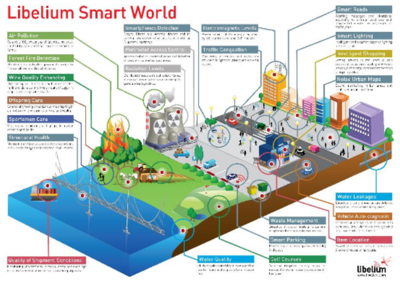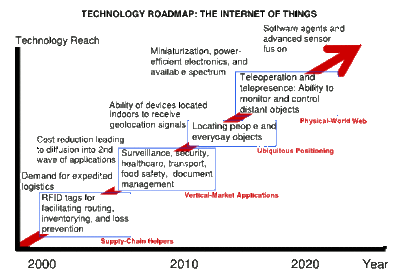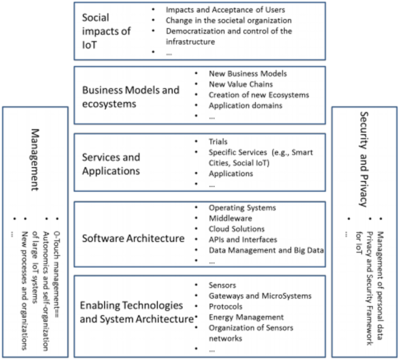Internet of Things (IoT)
Internet of Things Definition
The Internet of Things (IoT) is the network of physical objects that contain embedded technology to communicate and sense or interact with their internal states or the external environment.[1]
As of 2016, the vision of the Internet of things has evolved due to a convergence of multiple technologies, including ubiquitous wireless communication, real-time analytics, machine learning, commodity sensors, and embedded systems. This means that the traditional fields of embedded systems, wireless sensor networks, control systems, automation (including home and building automation), and others all contribute to enabling the Internet of things (IoT). The concept of a network of smart devices was discussed as early as 1982, with a modified Coke machine at Carnegie Mellon University becoming the first Internet-connected appliance, able to report its inventory and whether newly loaded drinks were cold. Mark Weiser's seminal 1991 paper on ubiquitous computing, "The Computer of the 21st Century", as well as academic venues such as UbiComp and PerCom produced the contemporary vision of IoT. In 1994 Reza Raji described the concept in IEEE Spectrum as "moving small packets of data to a large set of nodes, so as to integrate and automate everything from home appliances to entire factories". Between 1993 and 1996 several companies proposed solutions like Microsoft's at Work or Novell's NEST. However, only in 1999 did the field start gathering momentum. Bill Joy envisioned Device to Device (D2D) communication as part of his "Six Webs Framework, presented at the World Economic Forum at Davos in 1999. The concept of the Internet of things became popular in 1999, through the Auto-ID Center at MIT and related market-analysis publications. Radio Frequency Identification (RFID) was seen by Kevin Ashton (one of the founders of the original Auto-ID Center) as a prerequisite for the Internet of things at that point. Ashton prefers the phrase "Internet for Things." If all objects and people in daily life were equipped with identifiers, computers could manage and inventory them. Besides using RFID, the tagging of things may be achieved through such technologies as near field communication, barcodes, QR codes and digital watermarking. In its original interpretation, one of the first consequences of implementing the Internet of things by equipping all objects in the world with minuscule identifying devices or machine-readable identifiers would be to transform daily life. For instance, instant and ceaseless inventory control would become ubiquitous. A person's ability to interact with objects could be altered remotely based on immediate or present needs, in accordance with existing end-user agreements. For example, such technology could grant motion-picture publishers much more control over end-user private devices by remotely enforcing copyright restrictions and digital rights management, so the ability of a customer who bought a Blu-ray disc to watch the movie could become dependent on the copyright holder's decision, similar to Circuit City's failed DIVX.[2]
IoT Extends Internet Connectivity[3]
The Internet of Things (IoT) refers to the ever-growing network of physical objects that feature an IP address for internet connectivity, and the communication that occurs between these objects and other Internet-enabled devices and systems. The Internet of Things extends internet connectivity beyond traditional devices like desktop and laptop computers, smartphones and tablets to a diverse range of devices and everyday things that utilize embedded technology to communicate and interact with the external environment, all via the Internet.
The new rule for the future is going to be, "Anything that can be connected, will be connected." But why on earth would you want so many connected devices talking to each other? There are many examples for what this might look like or what the potential value might be. Say for example you are on your way to a meeting; your car could have access to your calendar and already know the best route to take. If the traffic is heavy your car might send a text to the other party notifying them that you will be late. What if your alarm clock wakes up you at 6 a.m. and then notifies your coffee maker to start brewing coffee for you? What if your office equipment knew when it was running low on supplies and automatically re-ordered more? What if the wearable device you used in the workplace could tell you when and where you were most active and productive and shared that information with other devices that you used while working? On a broader scale, the IoT can be applied to things like transportation networks: "smart cities" which can help us reduce waste and improve efficiency for things such as energy use; this helping us understand and improve how we work and live. Take a look at the visual below to see what something like that can look like.[4]

source: Forbes
"Simply, the Internet of Things is made up of devices – from simple sensors to smartphones and wearables – connected together," Matthew Evans, the IoT programme head at techUK. "It's about networks, it's about devices, and it's about data," Caroline Gorski, the head of IoT at Digital Catapult. An argument has been raised that only because something can be connected to the internet doesn't mean it should be, but each device collects data for a specific purpose that may be useful to a buyer and impact the wider economy. Within industrial applications, sensors on product lines can increase efficiency and cut down on waste. One study estimates 35 per cent of US manufacturers are using data from smart sensors within their set-ups. US firm Concrete Sensors has created a device that can be inserted into concrete to provide data on the material's condition, for instance. "IoT offers us opportunity to be more efficient in how we do things, saving us time, money and often emissions in the process," Evans said. It allows companies, governments and public authorities to re-think how they deliver services and produce goods. "The quality and scope of the data across the Internet of Things generates an opportunity for much more contextualized and responsive interactions with devices to create a potential for change," continued Gorski. IoT "doesn't stop at a screen".
Cisco Systems, which has a commercial interest in Internet connectivity, has started to keep track of connections to the Internet, including the independent devices that comprise the Internet of Things. Its last count, on June 20, 2013, was 9,907,090,400 devices. Cisco predicts that by the year 2020, 250 new things will connect to the Internet each second, and there will be 50 billion devices connected to the Internet at that time.[6]

source: Wikipedia
Popular IoT Applications[7]
- Wearables : Wearables Wearable technologies have started to make their presence felt in our day-to-day lives. Wearables are helping people to live healthier lives and plan out their daily tasks etc. On the other hand they are also helping businesses understand the needs and requirements of the business. Here are some common types of wearable devices available in the market: Infotainment Gaming Medical Lifestyle Entertainment Wearables are providing a huge opportunity to businesses for advertising and content integration. Wearable technology can also be used as an extension of a brand’s social media strategy.
- Smart Retail : Smart Retail Every consumer is looking for more, better and more engaging brand experiences, while they walk into a retail store. The mobile devices are playing an important role in improving these experiences. Beacons are one of the most powerful ways in which retailers are using technology for enhancing the experience of the consumer. Beacons can be easily used to provide offers and discounts to customers using their mobile application. Smart mirrors are also being used by retailers to help shoppers to try the dress virtually.
- Smart Homes: Smart Homes Another useful application of the IoT is smart homes. Home appliances such as coffee makers and refrigerators can be easily tracked and controlled using IoT apps. Similarly other appliances such as bulbs and computers can be turned on and off using IoT applications .
- Waste Management: Waste Management Smart sensors are now being used to track waste level at the dumpsters and improves efficiency of waste management. Tracking the waste created by companies and households helps in reducing the level of waste and garbage created by these entities.
- Health Care: Health Care IoT devices are making healthcare faster and more efficient. Devices and apps are being used for patient monitoring and collaboration among doctors. Patient data can be easily gathered using smart devices which are connected to patients.
- Smart Agriculture: Smart Agriculture The internet of things is fast converting Agriculture into smart agriculture. Information about various data sets such as those related to fertilizer applications, weather data and animal health are being used for analysing the yield level in this sector.
Generally speaking, the IoT covers many areas (see figure below) ranging from enabling technologies and components to several mechanisms to effectively integrate these low level components. Software is then a discriminant factor for IoT systems. IoT operating systems are designed to run on small scale components in the most efficient way possible, while at the same time providing basic functionalities to simplify and support the global IoT system in its objectives and purposes. Middleware, programmability – in terms of application programming interfaces (APIs) – and data management seem to be key factors for building a successful system in the IoT realm. Management capabilities are needed in order to properly handle systems that can potentially grow up to millions of different components. In this context, self-management and self-optimization of each individual component and/or subsystem maybe strong requirements. In other words, autonomics behaviors are the norm in large and complex IoT systems. Data security and privacy also plays an important role in IoT deployments. Because IoT systems produce and deal with personally identifiable information, data security and privacy iscritical from the very beginning. IoT also has an impact on people and the society they live in, and so it must be conceived and conducted within the constraints and regulations of each country.

source: IEEE
IoT Security and Privacy Issues[9]
Security
- Public Perception: If the IoT is ever going to truly take off, this needs to be the first problem that manufacturers address. The 2015 Icontrol State of the Smart Home study found that 44% of all Americans were "very concerned" about the possibility of their information getting stolen from their smart home, and 27% were "somewhat concerned." With that level of worry, consumers would hesitate to purchase connected devices.
- Vulnerability to Hacking: Researchers have been able to hack into real, on-the-market devices with enough time and energy, which means hackers would likely be able to replicate their efforts. For example, a team of researchers at Microsoft and the University of Michigan recently found a plethora of holes in the security of Samsung's SmartThings smart home platform, and the methods were far from complex.
- Are Companies Ready?: AT&T's Cybersecurity Insights Report surveyed more than 5,000 enterprises around the world and found that 85% of enterprises are in the process of or intend to deploy IoT devices. Yet a mere 10% of those surveyed feel confident that they could secure those devices against hackers.
- True Security: Jason Porter, AT&T's VP of security solutions, told BI Intelligence, Business Insider's premium research service, that securing IoT devices means more than simply securing the actual devices themselves. Companies also need to build security into software applications and network connections that link to those devices.
Privacy
- Too Much Data: The sheer amount of data that IoT devices can generate is staggering. A Federal Trade Commission report entitled "Internet of Things: Privacy & Security in a Connected World" found that fewer than 10,000 households can generate 150 million discrete data points every day. This creates more entry points for hackers and leaves sensitive information vulnerable.
- Unwanted Public Profile: You've undoubtedly agreed to terms of service at some point, but have you ever actually read through an entire document? The aforementioned FTC report found that companies could use collected data that consumers willingly offer to make employment decisions. For example, an insurance company might gather information from you about your driving habits through a connected car when calculating your insurance rate. The same could occur for health or life insurance thanks to fitness trackers.
- Eavesdropping: Manufacturers or hackers could actually use a connected device to virtually invade a person's home. German researchers accomplished this by intercepting unencrypted data from a smart meter device to determine what television show someone was watching at that moment.
- Consumer Confidence: Each of these problems could put a dent in consumers' desire to purchase connected products, which would prevent the IoT from fulfilling its true potential.
These are just a handful of the issues the IoT must solve in order to reach mass adoption. BI Intelligence, Business Insider's premium research service, has put together an extensive and detailed report that dives into each aspect of the IoT, from devices and analytics to networks and security.
See Also
Advanced Research Projects Agency Network (ARPANET)
Internet
Industrial Internet of Things (IIoT)
Internet Crime
Internet Privacy
Internet Reputation
Search Engine
Search Engine Optimization (SEO)
World Wide Web
Dark Web
Artificial Intelligence (AI)
Artificial General Intelligence (AGI)
Machine Learning
Machine-to-Machine (M2M)
Social Network
Social Networking
Social Media
Social Media Governance
References
- ↑ What is the Internet of Things (IoT) Gartner
- ↑ The History of Internet of Things (IoT) Wikipedia
- ↑ IoT Extends Internet Connectivity Webopedia
- ↑ How Does Internet of Things (IoT) Impact You? Forbes
- ↑ IoT - Why do connected devices need to share data? Wired
- ↑ The Internet of Things (IoT) Technology Roadmap Tikalon
- ↑ Popular IoT Applications ValueCoders
- ↑ Towards a definition of the Internet of Things (IoT) IEEE
- ↑ Security and Privacy Issues with the Internet of Things IoT Business Insider
Further Reading
- 15 Examples of the Internet of Things Beebom
- 12 best uses of IoT in the enterpriseComputerworld UK
- How People Are Actually Using the Internet of Things HBR
- How Many Internet Connections are in the World Cisco
